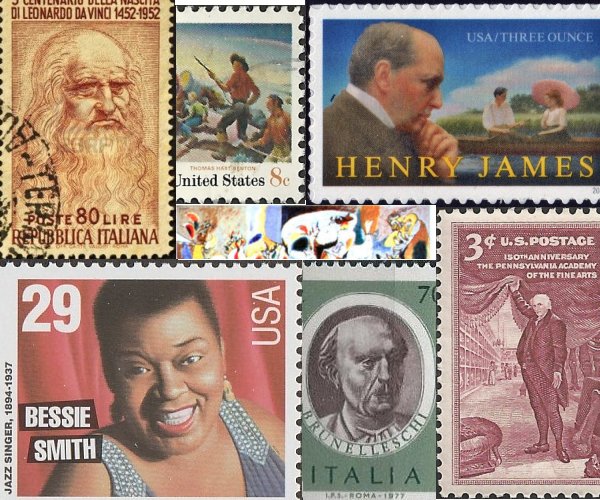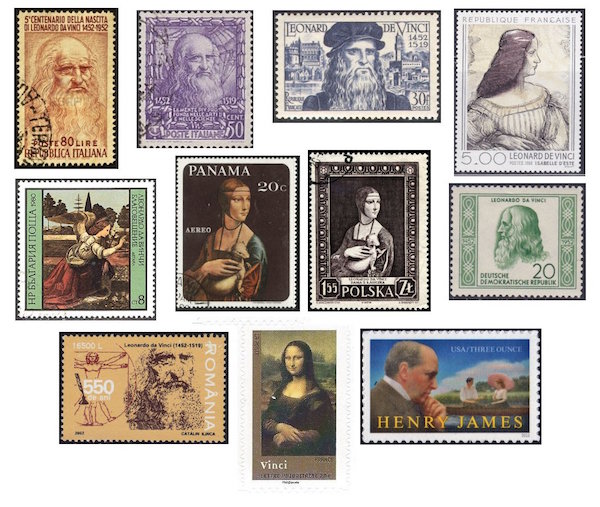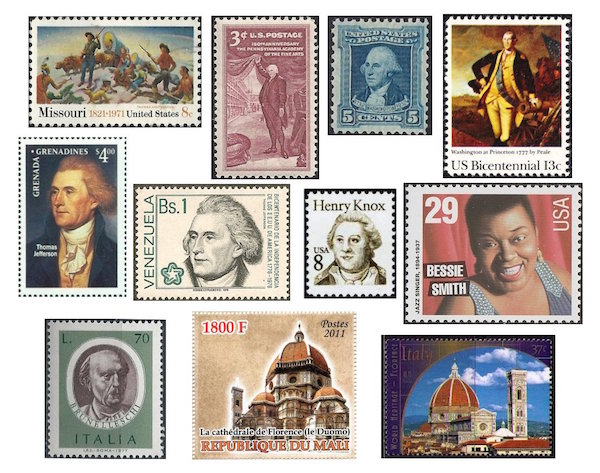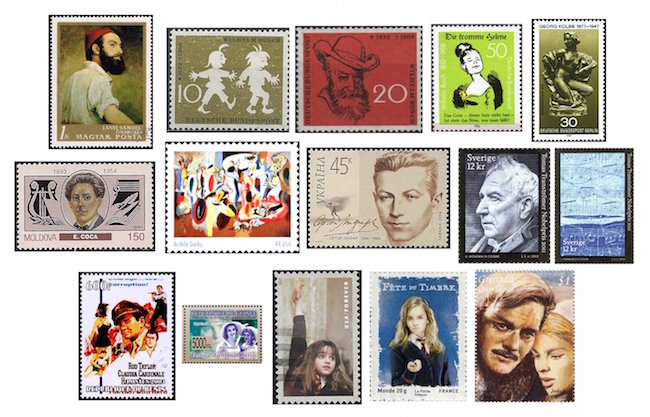The Arts on the Stamps of the World — April 15
An Arts Fuse regular feature: the arts on stamps of the world.

By Doug Briscoe
Another busy day is before us. On April 15 we salute Leonardo da Vinci, Henry James, Thomas Hart Benton, Charles Willson Peale, Bessie Smith, and more than a few others, and we remember the great genius Filippo Brunelleschi, who died on this date in 1446.
A little known fact about Leonardo da Vinci (15 April 1452 – 2 May 1519)—well, I didn’t know it—was that, according to Vasari, he was a very capable lyre-player. He also invented a musical instrument called the viola organista, a keyboard instrument similar in principle to a hurdy-gurdy. You can see a modern reconstruction of the instrument here. As for the Leonardo stamps, there are of course a host of them, and I offer ten choice specimens.
Shame! The towering literary figure of Henry James (15 April 1843 – 28 February 1916) was only recognized on a US stamp for the very first time last year, for his centennial. There have, of course, been many stage and film adaptations of James’s novels and stories, as well as various operatic treatments, most notably Benjamin Britten’s works The Turn of the Screw and Owen Wingrave. Easily my favorite production of a James novel, though, is the exquisite 1972 BBC dramatization of The Golden Bowl, with an impeccable cast: Gayle Hunnicutt as Charlotte, Barry Morse as Adam Verver, Jill Townsend as Maggie, and Daniel Massey (Raymond Massey’s son) as the Prince. But for me the most brilliant stroke was to take much of James’s narration and put it into the mouth of the minor character Bob Assingham, beautifully rendered by Cyril Cusack, who addresses the audience from a plush chair in his club.
We have two of the most prominent American painters on today’s “program”. The striking and immediately recognizable work of Thomas Hart Benton (April 15, 1889 – January 19, 1975) has found its way onto just a single US stamp, and that a commemorative to mark the sesquicentennial of the admission of Benton’s home state of Missouri to the union.
Charles Willson Peale (April 15, 1741 – February 22, 1827), however, has earned a bit more recognition philatelically because of his portraits of Washington, Jefferson, and other great figures of his day. In addition, though, there is a 1955 stamp that celebrates the 150th anniversary of the Pennsylvania Academy of the Fine Arts, co-founded by Peale, and a Peale self-portrait, The Artist in His Museum (1822), serves as the source of the image. We see two of his Washington portraits, the second one being George Washington at the Battle of Princeton (1781), and two foreign stamps that used his famous 1791 Thomas Jefferson. Peale also painted the Revolutionary American general (and later Secretary of War) Henry Knox in 1784, an image used for a 1985 Knox stamp.
The “Empress of the Blues”, Bessie Smith (April 15, 1894 – September 26, 1937), was an orphan by the age of nine, and her upbringing was taken over by her elder sister Viola. Bessie and her brother Andrew earned money as street performers in Chattanooga. Another brother, Clarence, had found work with a troupe run by Moses Stokes, and Bessie worked as a dancer with them from 1912. (The group already had a singer, Ma Rainey, whose stamp we’ll see later this month.) Smith made her first records in 1923 and before long was the highest paid African-American performer in the country. She died from injuries sustained in an automobile accident at the age of 43. Her common-law husband Richard Morgan (who happens to have been Lionel Hampton’s uncle) was driving.

Now time presses, and we must be brief, relatively. The exact birthday of Filippo Brunelleschi in 1377 is unknown. He died on April 15, 1446. His most celebrated work is without a doubt the Dome of Florence Cathedral, which occupied him from 1419 to 1436. (You can read about it in Ross King’s well-received book Brunelleschi’s Dome, Bloomsbury, 2000.)
Our next three subjects are all visual artists with their work concentrated in different media. Hungarian painter Sámuel Lányi (1792 – 9 March 1860), who earned has living as a hydraulic engineer, worked mostly in portraits and landscapes. The stamp shows his Self-portrait (1840).
Although he also painted, Wilhelm Busch (1832 – 9 January 1908) is better remembered as an illustrator and humorist who also wrote poetry. His creation Max and Moritz, a Story of Seven Boyish Pranks (1865), illustrated on the green 10-pfennig stamp, served as the inspiration for the American comic strip The Katzenjammer Kids. Busch’s targets were bigotry, hypocritical religiosity, and Philistinism. Next to the Self-portrait of 1894 (20-pfenning red stamp) we see another of Busch’s characters, Die fromme Helene, translated into English as Helen Who Couldn’t Help It (1872). The quoted text, an example of Helene’s smug wrongheadedness, has been translated as “The good (I am convinced, for one) / Is but the bad one leaves undone.” Busch’s influence on his Western European successors can hardly be overstated.
Another German artist, Georg Kolbe (1877 – 20 November 1947), was also a salient figure in his field, which was sculpture, particularly of the human form, dancers being a favorite topic. His most famous piece is Die Tänzerin, (The [Female] Dancer) of 1912, and the Harvard Art Museums hold his 1913 work The Dancer Nijinsky. On the stamp is a figure for a fountain dated 1919.
Romanian composer Eugeniu Coca (15 April 1893 – 9 January 1954) learned the violin from his father and played in a variety of orchestras before taking up a career as a music professor. He wrote in most genres, produced an opera and a ballet, two symphonies and two symphonic poems, etc.

Arshile Gorky (1904 – July 21, 1948) was born Vostanik Manoug Adoian in a village on Lake Van in what was then the Ottoman Empire. His father left the family to avoid conscription, and although Gorky himself escaped the Armenian genocide by fleeing into Russia, his mother died of starvation in Yerevan in 1919. The next year he rejoined his father in the United States, where he adopted his new name. Gorky lived in Boston, attending the New School of Design in 1922, thereafter living in New York. Following a series of misfortunes—a studio fire, cancer, an automobile accident in which his neck was broken, and his wife’s departure with their children—Gorky took his own life by hanging. On the stamp is The Liver is the Cock’s Comb (1944), declared by André Breton to be “one of the most important paintings made in America.”
Ballet dancer Serge Lifar was born Serhiy Lyfar on 15 April (O.S. 2 April) 1905 (or 1904) in Kiev, where he studied with Bronislava Nijinska. He left the USSR while still in his teens and danced with the Ballet Russes from 1923. He became director of the Paris Opéra Ballet at just 24 and revitalized that organization. He is credited with saving the lives of many dancers during the Nazi occupation of France and is held to be one of the greatest male ballet dancers of the 20th century. He died 15 December 1986 in Lausanne. Since 1994 a Lifar International Ballet Competition has been held in Ukraine.
The late Swedish poet Tomas Tranströmer (15 April 1931 – 26 March 2015) won the Nobel Prize in 2011 for his work as one of the most important Scandinavian writers of the post-war era. He worked as psychologist for juvenile offenders and in the 1960s became friendly with American poet Robert Bly, who translated some of Tranströmer’s work into English. A 1990 stroke left Tranströmer without speech and partially paralyzed. He continued playing his beloved piano with his left hand only. His poems have been set by many Scandinavian composers.

Now we turn to the acting profession. I could have sworn I’d seen a Claudia Cardinale stamp somewhere, but the only one I was able to find today was this curiosity from Benin showing the lobby card for an obscure 1968 flop called Hell Is for Heroes with Rod Taylor. Ms. Cardinale (born 15 April 1938) can barely be seen on that one. She is perhaps best known to American audiences for her role in Sergio Leone’s Once Upon a Time in the West (also from 1968). A happy birthday, too, to two actresses named Emma, Emma Thompson (born 1959) and Emma Watson (born 1990), who happen to have worked together in a few of the Harry Potter films. A Guinean stamp shows Emma Thompson (with Kate Winslet) in 1995’s Sense and Sensibility, though I was not able to find any image online other than this tiny one, and Emma Watson, it goes without saying, is portrayed on any number of international Harry Potter stamps, including these from the United States (2013) and France (2008). And while we’re on the subject, I take this opportunity to address a recent omission, or rather, two of them. It’s a case of killing two birds with one fell swoop. Omar Sharif (1932 – 10 July 2015) and Julie Christie (born 1940) happen to have had nearby birthdays, the 10th and the 14th respectively. So it was serendipitous, if belated, that I found them both on a single Doctor Zhivago stamp from Grenada Grenadines.
And on this day in 1755 Dr. Samuel Johnson’s Dictionary of the English Language was published in London.
In deference to my editor, and just to rub it in a little, I feel it incumbent upon me to mention that the 15th is the birthday of two stampless critics: the Greek poet, essayist, and art critic Jean Moréas (born Ioannis A. Papadiamantopoulos; 15 April 1856 – 31 March 1910), who wrote mostly in French, and the Russian poet and literary critic Nikolay Gumilyov (April 15, 1886 – August 25, 1921)
A graduate of the University of Massachusetts with a B.A. in English, Doug Briscoe worked in Boston classical music radio, at WCRB, WGBH, and WBUR, for about 25 years, beginning in 1977. He has the curious distinction of having succeeded Robert J. Lurtsema twice, first as host of WGBH’s weekday morning classical music program in 1993, then as host of the weekend program when Robert J.’s health failed in 2000. Doug also wrote liner notes for several of the late Gunther Schuller’s GM Recordings releases as well as program notes for the Boston Classical Orchestra. For the past few years he’s been posting a Facebook “blog” of classical music on stamps of the world, which has now been expanded to encompass all the arts for The Arts Fuse.
